

Home Guard - Godfrey
Sculpted by Barry Rigby
Article in Military Modelling magazine 2008
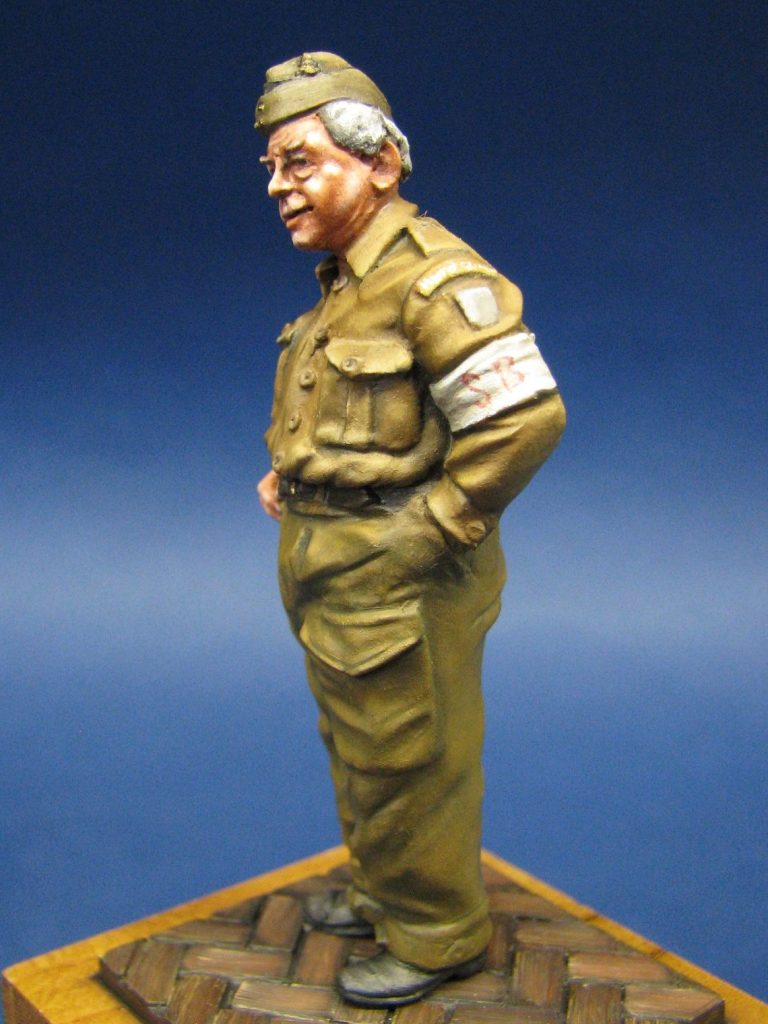
Now I know that I have mentioned once or twice that anything more recent than the 16th century isn’t my bag, but I do seem to be getting dragged into painting kits that depict “recent” military history.
Possibly because there’s quite a few nice pieces being released, and some of those are, to be honest, just too good to miss out on.
This model in particular is one such, and is inspired by a television series that I grew up with, the characters so well rounded that the series can be repeated endlessly and still cause the viewer to laugh.
Sculpted by Barry Rigby, this figure is one of a set ( granted an ongoing production ), which will depict the characters from a British Home Guard unit during the Second World War - but only as far as facial features are concerned. The battledress used for the series was gathered from allsorts of sources, whereas Barry has chosen to research the clothing actually used by the Home Guard, and depict that on these models instead.
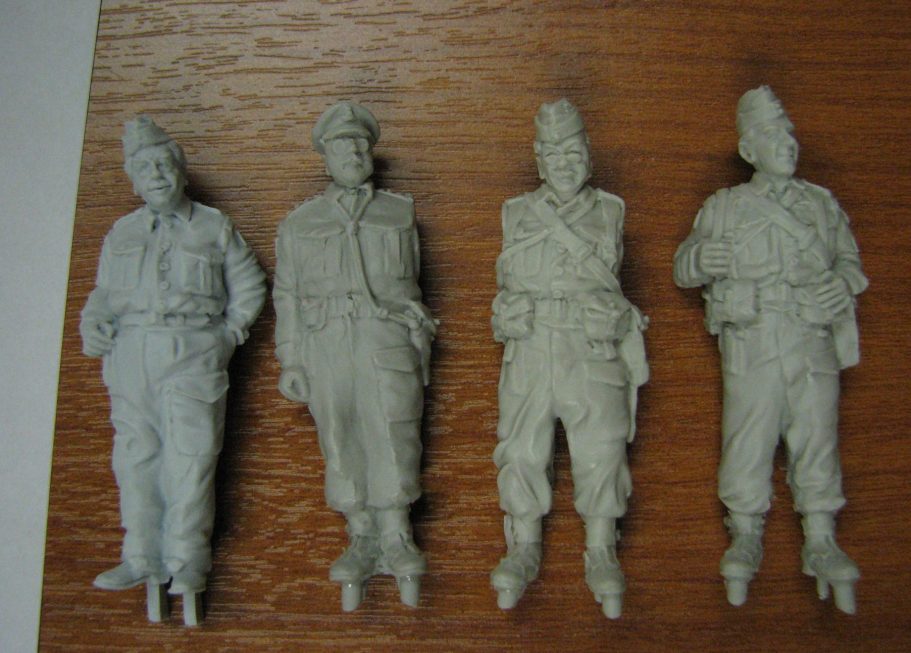
At the point when I first saw the models, Barry had managed to sculpt four of the main characters, and was still refining the details of these; so I actually got to see the master figures.
He’s concentrated on getting these four into production, having spoken to the BBC to clear up any copyright details, and is now ( at the time of writing this ) working on a fifth addition to the range.
The four figures available so far are shown in their raw resin state in photo #1 (the main castings only, as three of the figures have multiple parts ).
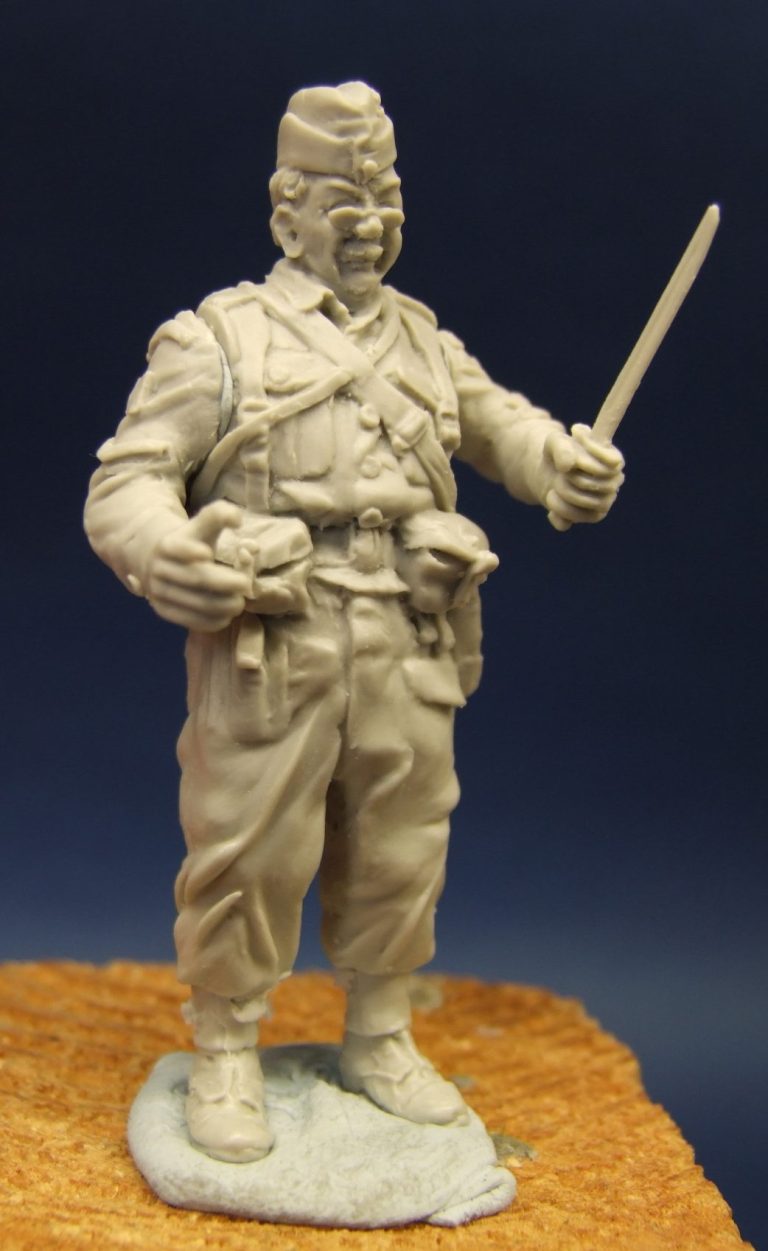
At the point when I first saw the models, Barry had managed to sculpt four of the main characters, and was still refining the details of these; so I actually got to see the master figures.
He’s concentrated on getting these four into production, having spoken to the BBC to clear up any copyright details, and is now ( at the time of writing this ) working on a fifth addition to the range.
The four figures available so far are shown in their raw resin state in photo #1 (the main castings only, as three of the figures have multiple parts ).
). I’ve taken separate shots of each of the figures in photos #2 through #5 showing the separate parts added as applicable - the kit’s being titles “Captain”, “Sergeant”, “Corporal” and “Medical Officer”. It’s the latter of these that interested me as a painting project, simply because I liked the character in the TV series.

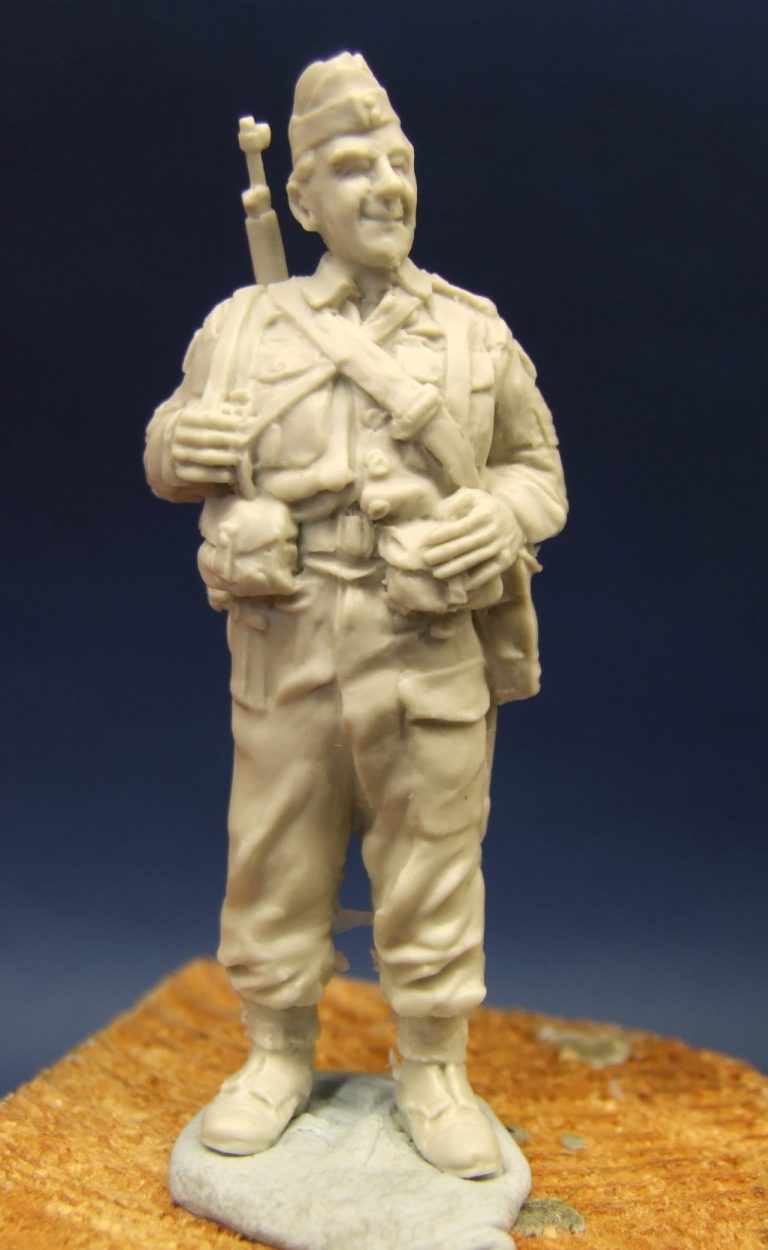

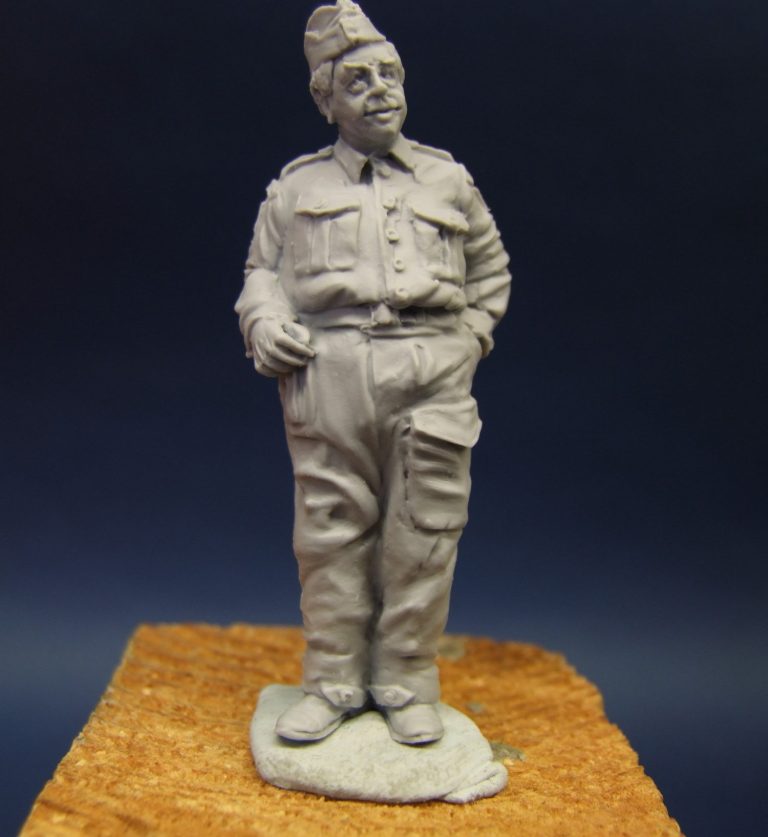
Painting.
Oh, alright, there’s a little bit of clean-up to do, but the casting is done By MDC ( Model Design Construction ) and the chaps there are somewhat good at their trade. So a couple of mould pips, and the odd part line to see to, but nothing major.
So after washing the one piece casting, I could dry it and then add a coat of primer. I use various acrylic paints for primers, simply choosing a colour that picks out detail and will be easy to cover with undercoats. In this case I made a mix of GW Chaos Black and some Bubonic Brown ( basically a black and a sand colour ) which would give a fair approximation of Olive Drab, and used some Isopropyl Alcohol to thin the paint so that the pigments merely tinted the liquid being applied.
The results of this can be seen in photo #6 on the face, where the grey resin is still showing through the thin wash of primer.
The rest of the figure – well the clothing areas – have been undercoated with the same mix of black and sand colour acrylic, and three layers of paint added to the casting.
Why three layers – well simply so I can thin the acrylic with water. This allows the paint to flow onto the model easily, and although the first two coats might not cover the grey resin completely, the third will usually take care of that; and in the process the paint hasn’t built up in thickness to hide any of the sculpted details.
Then the model was added to a decorative base and that was it………
What ?
Oh, I missed a bit out.
Well there’s a reason for that.
Y’see, this should have been an easy model for me to paint. I mean, it’s Olive Drab and flesh colour. Simple eh ?
Well, I’d thought so too, but I was in for a shock.


I wanted a particular “look” to the model, one of slight mismatches in clothing colour, trying to suggest old stock battledress, with an amount of washed out / faded colour thrown into the mix for good measure.
So confident was I, that I bypassed the usual rule of painting the face first, and went straight on to the clothing - BIG mistake.
Below is detailed the rather repetitive, and rather forlorn attempt at painting the trousers. Hey, once I’ve got those right, I can go do the shirt and the cap !
First try.
With the undercoat established, what could be easier than to mix some Mars Yellow and Mars Black oils, paint it onto the clothing areas, add shadows with more black, and highlights with more of the yellow.
Result, too dark, but also really shiny once dry.
So, strip off the paint and re-undercoat.
Second try.
Same mix as above, added more Mars Yellow to the initial mid-tone and a drop of Humbrol Matt-cote as well. Shadows and highlights as above.
Grrrrrrrr. Still shiny, although better colour. A bit too green.
So, strip off the paint and re-undercoat.
Third Try.
Same colours, more Yellow, more Matt-cote, shadows and highlights as above
Hmmmm, the drying cabinet and the Matt-cote obviously aren’t working. It’s still shiny, although the colour isn’t too bad.
So, strip off the paint and re-undercoat.
Fourth try
Acrylics. These shall be my saviour.
A Chaos Black and Bubonic Brown mix ( both Games Workshop colours ), to match the best of the above mid-tones, very thin washes of darkened paint to build up to almost pure black for the shadows, then back to the mid-tone mix, adding small amounts of the Bubonic Brown and more water to create washes that can be used to build up the highlights.
Nice matt finish resulted, but quite a few “water marks” visible and also way too dark. Acrylics dry darker than when wet, as opposed to oils drying lighter. It’s been a while since I painted any large area with acrylics ( well barring something German and in black, which doesn’t really count ), so this looked way too dark.
Like a lot of my old school reports - especially Religious Education – “|Could do better”
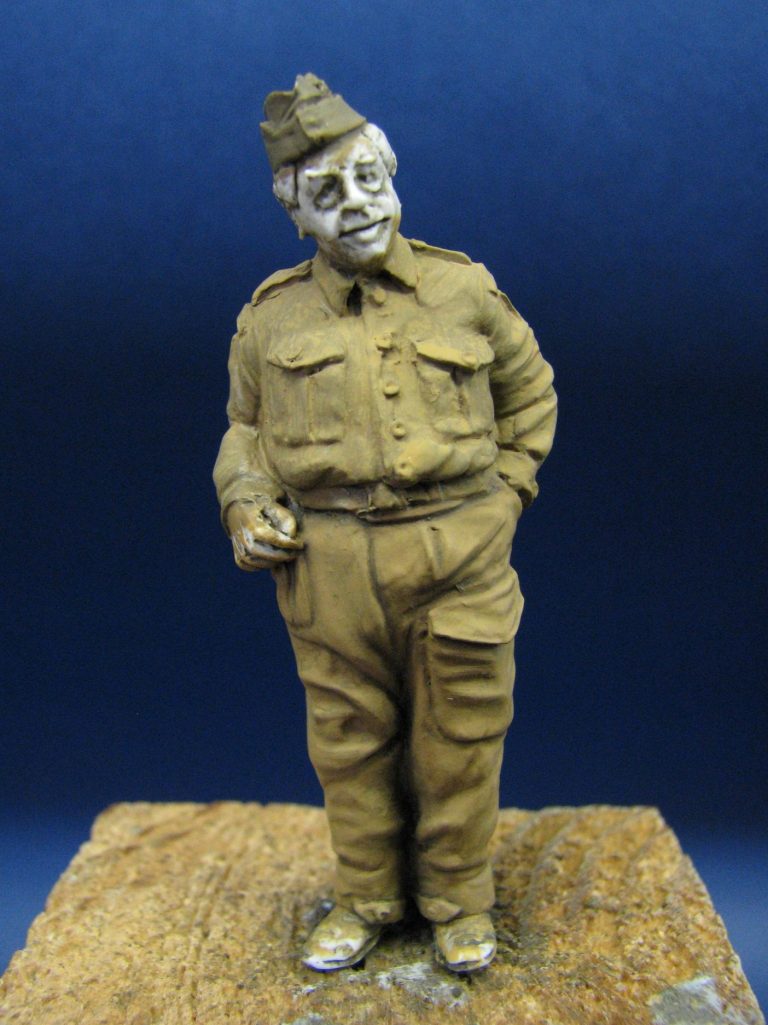
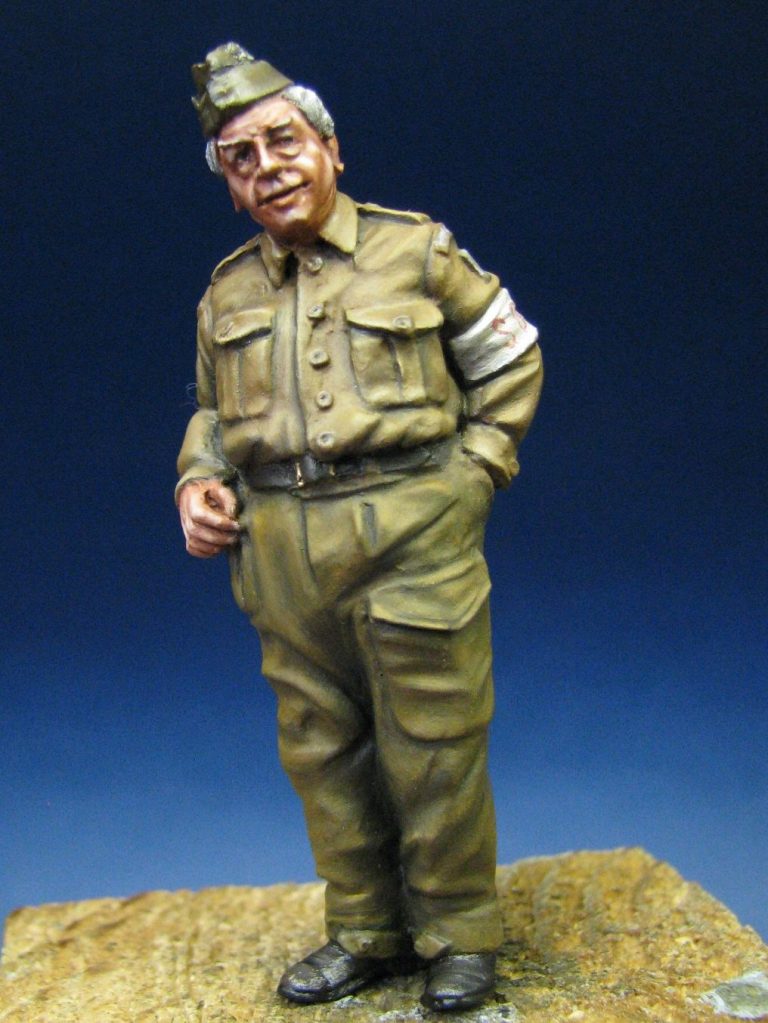
So, strip off the paint and re-undercoat.
Fifth try.
Again attacking with the acrylics – well it wasn’t all that bad last time !
Um……nicer, smoother result, but still too dark.
Do I need to say the “strip paint off……”
Sixth, and seventh try.
As above with the acrylics. Still too dark, but getting there – see photo #7
Um, paint stripped off etc…….
Eighth ( might have been ninth try – I was beginning to lose the will to live ! )
See how patient I am. If only you could hear the cursing !
In frustration, I returned to the oils, and things seemed to go right. The result wasn’t completely matt, but the colour was what I wanted, and the satin finish I could live with.
Simply because luck seemed to be on my side, I painted the shirt and cap at the same time, trying to difference the colours by adding a couple of dabs of Mars Brown and some more of the Mars Yellow to the mix for the mid-tone starting point.
I was aiming to make the separate items of clothing look slightly different, hinting at either separate supply sources and possibly even older / newer items being worn to make up a uniform.
I think it works well enough. The basic colours all match, but the shirt stands out enough as a separate item from the trousers. See photo #8
Moving on.
The face was plain sailing really. Barry has done a very good likeness, and it takes no real effort from the painter to make the model look like the actor. I think I may have erred on having the skin tone a little too dark, but I was thinking of photography and also the show bench, rather than standing this next to a television reproduction still for comparison.


The only other things to paint are the belt – dark brown ( Mars Black and Mars Brown with highlights of Light Red – all oils and all W&N ); the buttons, a darker Khaki colour from the clothing. These were early plastic ( Bakelite ) items on the uniforms I’ve looked at, and are a very similar colour to the uniform.
Final touches are the armband to denote him as a medic. I chose to paint this with a dull red “SB”, rather than the Red Cross emblem. The SB stands for Stretcher Bearer and is possibly old stock held over from the First World War.
The arch shaped shoulder badge has very fine lettering painted on – “Home Guard” in a light khaki lettering. A fine brush and a steady hand are needed at this scale, but perseverance and a few muttered curses seemed to help a lot too.
And that was the figure finished.
A base.
Now memories of the series were a bit hazy for scenery, I remember a van, and I think an artillery piece, might have been a 40mm Bofor’s or some such, but none of these were handy on my workbench.
I took the model down to my not-so-local club at Bolton, and Barry happens to be a member there too. He liked the figure, and suggested ( jokingly I think ) a parquetry floor section – “Just knock one up Adrian.” Was his passing comment.
But how to do one of those ?
Now I’m sure that there’s a company out there who make sections of floor just for this purpose, but I’m too lazy to look for them. I simply got some plasticard and a metal rule, a sharp knife and a cutting matt and set to work cutting thin strips of plasticard, then sectioning it into appropriately sized “block faces” for the individual parquet pieces.


These were glued onto a separate piece of Plasticard that I’d cut to size to match the top of one of Dave Armstrong’s plinths. I glued the separate pieces on in an herringbone pattern - common to so many parish rooms and community halls dotted around our green and pleasant land. How quintessentially English – someone break out the cucumber sandwiches !
Painting the flooring was a doddle too, the separate pieces, now secure on the backing card allowed me definition enough to paint each one separately, starting with a very dark brown mix ( Mars Black and Mars Brown ) and then working through Mars Brown, Light Red and Mars Yellow to build up grain detail.
The floor is shown in its painted state in photo #9. I realize that the gaps are over-scale, but if I’d made them too tight a fit, then the effect of separate blocks would have been lost.
Final thoughts.
All this series of figures are designed as a cross-over between the Toy Soldier and a military figurine. I’m sure that the separation between the two genres might mean different things to different people, but the idea behind the design is pretty straightforward.
Sculpting a likeness is one of the most difficult things to do. Taking a two dimensional picture and making it three-dimensional without ever seeing the real face is a skill not every sculptor can boast. These little offerings do resemble their famous counterparts, and certainly painting this one hasn’t caused any problem as far as getting the likeness to the character.
There’s another three main characters to go in Home Guard uniform that Barry hasn’t had chance to do yet, although I hear that the chap who was always on the fringe of what was legal, is being done at the moment. After that there’s a few other characters to sculpt perhaps, to round out this little series of figures. Who knows how this series might develop.


Simply taken as a bit of fun, these little models are very good. As a trip down memory lane, either from having watched the old television series, or simply as a military link to how things were being taken care of at home whilst the war was being fought in Europe; well they’re still something to spark interest.
I’m sure that there will be some who question copyright in relation to these figures, and Barry has been very careful to contact people at the BBC.
Fortunately for us modellers, the people he managed to get in touch with not only seemed content to let the models exist; but also seemed pleased that folk would be interested in a series of programs originally made several decades ago.
Whilst sculpting of these models has been inspired by a television series, the truth is that they give tribute both to the writers, producers and most importantly, to the actors – several of whom are no longer with us. The series might well be old and oft repeated, but watching it again we’re reminded not only of the hardships that those at home suffered during the war years, but the brilliance of writing and acting that went into the series and the simple but effective comedy that employed polite language, perfect timing and a fair amount of skill in it’s delivery.
Dare I say “the good old days !”
Thanks to Barry Rigby for sending in the review sample, I’m sure there’s many of us looking forward to seeing the other models in this series appear.